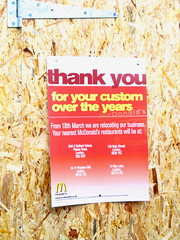




|
|||
 |
|||
> My stuff
> The Persuader Blog |
8.6.06 The folly of repositioning Mark Ritson, one of the more intelligent branding commentators, writes about McDonald’s today. The company is suffering because its brand is confused: its constant repositionings have weakened it. Mark Ritson, one of the more intelligent branding commentators, writes about McDonald’s today. The company is suffering because its brand is confused: its constant repositionings have weakened it.It reminds me of Coca-Cola’s initial ‘Always’ campaign, where I could never work out if it was a youthful brand or a traditional one. It was probably meant to be postmodern, but the average punter didn’t know that after a decade of seeing very “American” campaigns. And it reminds me of Rover under BMW, when the German company could never decide if it had acquired a premium brand or a mass-market one. And then it could not decide whether Rover was a BMW division or not, as far as the public were concerned. That took six years. McDonald’s has taken a lot less time to create its conflicting propositions and, therefore, images. He writes: And so it goes on and on. Upmarket, low class. Professional women, working-class men. Healthy eating, artery-blocking burgers. Trendy design brand, high-street standard. But what was really compelling was this: If you believe the text books, the brand can reposition itself. But repositioning is a managerial myth. Brands can be revitalised by renewing their existing values for a new market, but changing the fundamental brand associations is impossible. Name a brand that has done it successfully. Fundamentally, Mark is correct. Every established brand begins with an existing image. The ability for a repositioning to replace that image is a function of the existing image’s strength in the market-place, differentiation, symbolism (including graphic design), communication strength (as in media placements and PR) and budget. Impacting on that are the usual market orientation factors (from Narver and Slater) of management commitment, facilitative management and interdepartmental connectedness. That’s an awful lot of factors to get right. Therefore, it is easier to use elements of an existing image. McDonald’s is living proof that even with huge budgets, existing images have a lot of stickiness—and it is a victim of its own prior success, and its earlier inability to change with the times. Del.icio.us tags: brand branding brands McDonald’s repositioning brand associations image Posted by Jack Yan, 12:55 Comments:
Jack, I think, brand re positioning, particularly for the established brands, is utterly conflicting, if not difficult. When you begin, you are very methodical, focussed. But a decade down the line you find things are pretty haphazard and you have already lost focus. It's very natural and happens to us in perhaps every aspects of life. You begin agian, from the scratch, again lose focus only to repeat the process. It's a cycle. But when you are far too removed from the focus and left posts in many places, the conflict begins.
BMW perhaps found Rover too big a bait to gulp ! Quite a few of Rover automobiles were direct threat to BMW's line. A cannibalization was imminent. Same could be said for VW's effort of Rover's acquisition. GM, also in a similar move to re-position Chevrolet as a global brand in the emerging markets like China, India, and Russia is fixed in a similar situation. They are killing the essence of an immensely valuable brand [no wonder, if it goes the Oldsmobile way]. A good option was perhaps retaining Daewoo as their mass-market global automobile.
This was done in an academic framework to be sure, but in our Marketing class several groups (brands) competed against each other in a fictitious marketplace using the computer program MARKSTRAT. What our group found that it was often necessary to reposition our brand in order to increase profits (in response to similar strategic moves by the competition), but the repositioning had to be done incrementally and the repositioning feedback had to be paid close attention to.
Agreed, we didn't have the baggage that a McDonald's has...
Rohan, it is true that repositionings are tough, and Chevrolet in Europe and Asia is an excellent example. It also ignores that people travel more, so the message will conflict with marketing in the US. Which brings me to Anonymous’s comment: it is true that repositionings can be done, but it is a function of the things I mentioned. So a complete departure is impossible, but gradual changes are not, because the existing image’s hold on an audience can be very strong.
I agree that companies are far less in control of their brand's position or the consumer's brand associations than they would like to think.
One particular retail brand comes to mind, though. Do you believe Banana Republic actually managed to change its brand associations, effectively repositioning itself when it was acquired and reinvented by The Gap (from a safari chic outfit in the 80s?)
Not being American, Monica, I am unfamiliar with these brands’ history, sorry. Of course, I have heard of them, and seen their marketing, but that would be from the late 1990s on.
Post a Comment
Links to this post:
|
NoteEntries from 2006 to the end of 2009 were done on the Blogger service. As of January 1, 2010, this blog has shifted to a Wordpress installation, with the latest posts here.With Blogger ceasing to support FTP publishing on May 1, I have decided to turn these older pages in to an archive, so you will no longer be able to enter comments. However, you can comment on entries posted after January 1, 2010. Quick links Add feeds
|
|
DonateIf you wish to help with my hosting costs, please feel free to donate. |
|||
Copyright ©2002–10 by Jack Yan & Associates. All rights reserved. Photograph of Jack Yan by Chelfyn Baxter. | |||